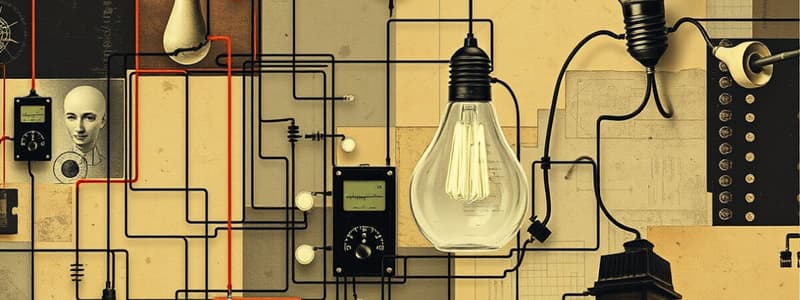Podcast
Questions and Answers
What factors need to be considered when determining the number and type of circuits in an electrical installation? (Select all that apply)
What factors need to be considered when determining the number and type of circuits in an electrical installation? (Select all that apply)
- What is the intended use of the socket outlets (correct)
- The purpose of the installation (correct)
- Is there any electrical heating in the installation (correct)
- The rating of the equipment (correct)
An electrical installation should be arranged into an appropriate number of circuits to ensure the following... (Select all that apply)
An electrical installation should be arranged into an appropriate number of circuits to ensure the following... (Select all that apply)
- To make finding faults easier (correct)
- To limit overloading (correct)
- To limit the loss of supply to critical equipment wherever possible (correct)
- To increase the cost of the installation
- To allow for maintenance, alterations and additions (correct)
- Faults occur across multiple circuits
A separate circuit shall be provided for all equipment that is greater than 30 amps.
A separate circuit shall be provided for all equipment that is greater than 30 amps.
True (A)
A separate circuit should be provided for all equipment that is greater than how many amps?
A separate circuit should be provided for all equipment that is greater than how many amps?
Which type of equipment is most likely to cause nuisance tripping when connected to an RCD protected circuit?
Which type of equipment is most likely to cause nuisance tripping when connected to an RCD protected circuit?
Maximum demand is...
Maximum demand is...
For final sub-circuits, maximum demand can be determined by... (Select all that apply)
For final sub-circuits, maximum demand can be determined by... (Select all that apply)
Which of the following installations has the highest changes in seasonal demand?
Which of the following installations has the highest changes in seasonal demand?
Which of the following installations has the lowest changes in seasonal demand?
Which of the following installations has the lowest changes in seasonal demand?
Changes in seasonal demand are caused by which electrical equipment? (Select all that apply)
Changes in seasonal demand are caused by which electrical equipment? (Select all that apply)
Which of the following electrical diagrams is best used to aid in wiring circuit, installation or equipment and shows components in the same physical layout?
Which of the following electrical diagrams is best used to aid in wiring circuit, installation or equipment and shows components in the same physical layout?
Which of the following electrical diagrams is best used to provide a logical sequence of the operation of a circuit and is used in fault finding?
Which of the following electrical diagrams is best used to provide a logical sequence of the operation of a circuit and is used in fault finding?
Which of the following electrical diagrams shows the arrangement of switching, protection and control of an electrical installation?
Which of the following electrical diagrams shows the arrangement of switching, protection and control of an electrical installation?
Which of the following electrical diagrams shows the basic function of the main components and how they interconnect?
Which of the following electrical diagrams shows the basic function of the main components and how they interconnect?
An electrical specification forms a part of a contract between parties and is legally binding.
An electrical specification forms a part of a contract between parties and is legally binding.
Which of the following is a template used for the specifications of electrical installations as it standardizes the format and language used?
Which of the following is a template used for the specifications of electrical installations as it standardizes the format and language used?
All supplies less than 50V a.c. or 120V d.c. meet the requirements of ELV in AS3000.
All supplies less than 50V a.c. or 120V d.c. meet the requirements of ELV in AS3000.
An extra low voltage system that does not meet the requirements of SELV or PELV needs to be treated as low voltage and meet all the installation requirements for low voltage.
An extra low voltage system that does not meet the requirements of SELV or PELV needs to be treated as low voltage and meet all the installation requirements for low voltage.
Common applications of extra low voltage installations include...(Select all that apply)
Common applications of extra low voltage installations include...(Select all that apply)
Electrical separation provides protection from electrical shock by...
Electrical separation provides protection from electrical shock by...
Flashcards are hidden until you start studying
Study Notes
Circuit and Control Arrangements for Electrical Installations
- Circuit Considerations: Factors affecting the number and type of circuits include installation purpose, equipment rating, socket outlet usage, and presence of electrical heating.
- Circuit Organization: Proper arrangement of circuits is crucial to limit equipment supply loss, prevent overloading, simplify fault finding, and allow for maintenance and installation modifications.
- High Amp Equipment: A separate circuit is required for any equipment exceeding 30 amps, emphasizing safety and proper load distribution.
- Lighting Circuits: A circuit protected by an 8 amp breaker can typically support up to 16 lights, ensuring adequate capacity for common installations.
- Multiple Points: Lighting circuits often have multiple points installed, facilitating widespread illumination while managing load effectively.
- Kitchen Circuits: It's recommended to dedicate one circuit for kitchens to manage the high demand from multiple equipment while avoiding overload.
- RCD Protection: Class I equipment is more likely to cause nuisance tripping on RCD protected circuits, impacting operational reliability.
- Maximum Demand: Defined as the continuous current required for reliable operation within an installation or circuit.
- Final Sub-circuit Demand: Maximum demand can be assessed through the actual current of connected equipment, protective device size, and cable capacity, alongside diversity determinations.
- Seasonal Demand Changes: Domestic installations have the greatest variations in seasonal electrical demands compared to commercial or industrial installations.
- Equipment Influencing Demand: Seasonal demand changes are influenced by electrical heating, clothes dryers, and hot water systems.
- Wiring Diagrams: Wiring diagrams showcase components in the same physical layout, aiding in installation and troubleshooting.
- Schematic Diagrams: Circuit (Schematic) diagrams provide a logical sequence of circuit operations beneficial for fault-finding.
- Electrical Specifications: An electrical specification is legally binding, forming part of a contract between involved parties, ensuring clarity and compliance.
- Standardized Templates: NATSPEC serves as a standardized template for electrical installation specifications, promoting consistency in language and format.
- Extra Low Voltage Systems:
- PELV connects one side of the secondary supply to the low voltage earthing system.
- SELV keeps the secondary supply isolated from the earthing system for enhanced safety.
- ELV Compliance: Supplies below 50V AC or 120V DC align with ELV requirements as per AS3000 standards.
- Low Voltage Treatment: Systems failing to meet SELV or PELV standards must be treated as low voltage, adhering to appropriate installation guidelines.
- Common Applications: Extra low voltage installations are typically used in pool lighting, water feature pumps, and sanitization areas to ensure safety and efficiency.
- Electrical Separation: Protection from electric shock is achieved by ensuring that all exposed conductive parts are NOT connected to earth, effectively isolating potential hazards.
Studying That Suits You
Use AI to generate personalized quizzes and flashcards to suit your learning preferences.




